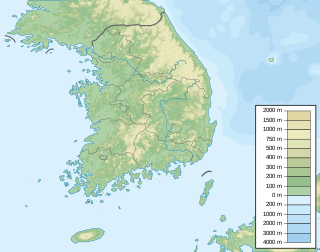 W
WThe Chilgog Formation, also known as the Chilgok Formation is an Early Cretaceous geologic formation in South Korea. Formerly dated to the Berriasian to Hauterivian, later dating has established an Albian age. Dinosaur remains, possibly of sauropods, are among the fossils that have been recovered from the formation, although none have yet been referred to a specific genus.
 W
WThe Geoncheonri Formation is an Early Cretaceous (Albian) geologic formation of the Hayang Group in the Gyeongsang Basin of southeast South Korea. Fossil ornithopod tracks, as well as fossils of Kirgizemys have been reported from the lacustrine siltstones and mudstones of the formation.
 W
WThe Gugyedong Formation, also known as the Guyedong Beds, is an Aptian to Albian geologic formation in South Korea. Dinosaur remains diagnostic to the genus level are among the fossils that have been recovered from the formation.
 W
WThe Haman Formation is an Early Cretaceous geological formation in South Korea. It has been dated to the Albian, with an estimated maximum depositional age of 105.4 ± 0.4 Ma. The deposit is known for its tracks, including those of dinosaurs, pterosaurs and birds. It overlies the Silla Congomerate which overlies the Chilgok Formation. It is laterally equivalent to the Sagog Formation.
 W
WThe Hasandong Formation is an Early Cretaceous geologic formation in South Korea. It has been dated to the late Aptian and earliest Albian, between 118.0 ± 2.6 Ma and 112.4 ± 1.3 Ma. Dinosaur remains diagnostic to the genus level are among the fossils that have been recovered from the formation. Tracks of the pterosaur ichnogenus Pteraichnus have also been recovered from the unit.
 W
WThe Jeomgog Formation is an Early Cretaceous (Albian) geologic formation of the Hayang Group in the Gyeongsang Basin of South Korea.
 W
WThe Jindong Formation is a geological formation located in South Korea. It dates to the Cenomanian stage of the Late Cretaceous, with a maximum depositional age of 99.9 ± 0.7 Ma.
 W
WThe Jinju Formation is an Early Cretaceous geologic formation in South Korea. Dinosaur remains are among the fossils that have been recovered from the formation, although none have yet been referred to a specific genus. It has been dated to the Albian stage. It predominantly consists of black shale, interbedded with sandstone packets, deposited in a fluvial-lacustrine setting.
 W
WThe Sagog Formation is an Albian geologic formation in South Korea.
 W
WThe Seonso Conglomerate is a Mesozoic geologic formation in South Korea. Fossil of Asprosaurus, Koreanosaurus and some dinosaur eggs have been reported from the formation.
 W
WThe Uhangri Formation, located at the Uhangri Dinosaur Fossil Site, is a geological formation from which fossil pterosaur tracks have been recovered near Haenam-eup, Jeollanam-do, South Korea.